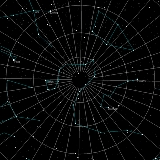
Ecliptic pole
Encyclopedia
The ecliptic pole is the point on the celestial sphere
where the sphere meets the imaginary line perpendicular to the ecliptic plane
, the path the Earth
travels on its orbit around the Sun
.
There are two ecliptic poles:
Due to Precession, the celestial pole
moves in a circle around the ecliptic poles once every 25,800 years.
The ecliptic poles are (as of epoch 1 January 2000) at:
when expressed in equatorial coordinates, as a consequence of the Earth's axial tilt
.
It is not possible to have the ecliptic poles at the zenith in a dark sky. By definition, the ecliptic poles are located 90 degrees from the Sun's position. Therefore, whenever either ecliptic pole is at the zenith, the Sun must be on the horizon.
Celestial sphere
In astronomy and navigation, the celestial sphere is an imaginary sphere of arbitrarily large radius, concentric with the Earth and rotating upon the same axis. All objects in the sky can be thought of as projected upon the celestial sphere. Projected upward from Earth's equator and poles are the...
where the sphere meets the imaginary line perpendicular to the ecliptic plane
Plane of the ecliptic
The plane of the ecliptic is the plane of the Earth's orbit around the Sun. It is the primary reference plane when describing the position of bodies in the Solar System, with celestial latitude being measured relative to the ecliptic plane. In the course of a year, the Sun's apparent path through...
, the path the Earth
Earth
Earth is the third planet from the Sun, and the densest and fifth-largest of the eight planets in the Solar System. It is also the largest of the Solar System's four terrestrial planets...
travels on its orbit around the Sun
Sun
The Sun is the star at the center of the Solar System. It is almost perfectly spherical and consists of hot plasma interwoven with magnetic fields...
.
There are two ecliptic poles:
 The North Ecliptic Pole is in Draco Draco (constellation) Draco is a constellation in the far northern sky. Its name is Latin for dragon. Draco is circumpolar for many observers in the northern hemisphere... . |
 The South Ecliptic Pole is in Dorado Dorado Dorado is a constellation in the southern sky. It was created in the late 16th century and is now one of the 88 modern constellations. Its name refers to the dolphinfish , which is known as dorado in Spanish, although it has also been depicted as a swordfish... |
Due to Precession, the celestial pole
Celestial pole
The north and south celestial poles are the two imaginary points in the sky where the Earth's axis of rotation, indefinitely extended, intersects the imaginary rotating sphere of stars called the celestial sphere...
moves in a circle around the ecliptic poles once every 25,800 years.
The ecliptic poles are (as of epoch 1 January 2000) at:
- (North) right ascensionRight ascensionRight ascension is the astronomical term for one of the two coordinates of a point on the celestial sphere when using the equatorial coordinate system. The other coordinate is the declination.-Explanation:...
(exact), declinationDeclinationIn astronomy, declination is one of the two coordinates of the equatorial coordinate system, the other being either right ascension or hour angle. Declination in astronomy is comparable to geographic latitude, but projected onto the celestial sphere. Declination is measured in degrees north and...
- (South) right ascension (exact), declination
when expressed in equatorial coordinates, as a consequence of the Earth's axial tilt
Axial tilt
In astronomy, axial tilt is the angle between an object's rotational axis, and a line perpendicular to its orbital plane...
.
It is not possible to have the ecliptic poles at the zenith in a dark sky. By definition, the ecliptic poles are located 90 degrees from the Sun's position. Therefore, whenever either ecliptic pole is at the zenith, the Sun must be on the horizon.

